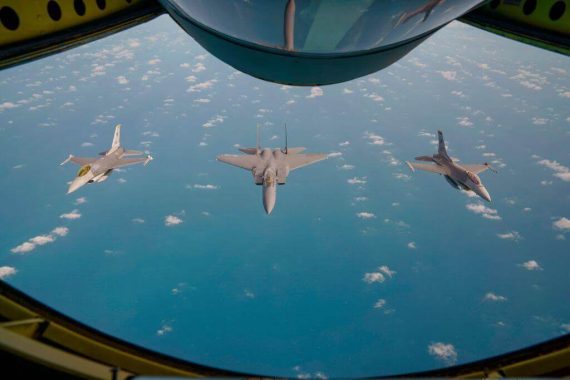Amid the Russia-Ukraine war in Europe, the United States has reaffirmed its commitment to counter China in the strategically vital Indo-Pacific region, by putting $2.2 billion on the table.
But in the end, what price are the regional and world powers willing to pay—not only in financial terms—to ensure a free and open South China Sea against the backdrop of China’s rising military maneuvering?
Bone of contention
The South China Sea, which encompasses 1.4 million square miles, is of tremendous economic and geostrategic importance. More than $3 trillion in trade is transported over it each year, and roughly one-third of the world’s maritime shipping moves through its waters. It also hosts a huge number of fisheries, indispensable for the food security of China, Southeast Asia, and beyond.
Yet, apart from the economic benefits, this large swath of war is on the top agenda of many countries due to its geopolitical significance. From a narrow perspective, only a few neighboring nations have domain over parts of the South China Sea due to their respective geographic position. This includes China, Taiwan, Vietnam, the Philippines, Malaysia, and Brunei. Nevertheless, many other countries such as Indonesia, Singapore, Cambodia, and Japan play a vital role in this maritime region, extending the circle of the partners involved.
Stirring opposition, China has claimed not only most of the waters of South China Sea for itself, but also competes for two groups of islands of strategic importance: the Spratly Islands and the Paracel Islands are contested by China and other neighboring countries.
No one wants to abandon their claims, given the richness in deposits of natural resources, and the potential to strengthen a country’s security and to open trade routes. This creates a source for a conflict which some have attempted to resolve by negotiation and legal challenges. So far, this has been in vain.
Empires’ loud talk
In the whole saga of this maritime dispute, the United States’ role cannot be ignored. The country evokes legal treaties such as the United Nations Convention on the Law of the Sea (UNCLOS) to affirm the claim that the South China Sea is international waters and accuses China of militarizing the area. In recent years, artificial islets have been built by China, and some of the reefs have been converted to military facilities, paving the way for the dominance of one power.
In addition, the American side accuses China of bending the rules of international law by creating a veneer of legitimacy. China uses the “nine-dash line” to delineate all its claims, encompassing 80% of the sea and backs it up with the history of the Chinese people sailing throughout this sea, which dates back to the 2nd century BCE.
But international law rejects historical arguments in this case. How does China react? It seeks to interpret another term, this time, of the territorial sea as the legal grounds for supposedly eliminating the presence of other powers. But this also stands in contradiction to the broadly accepted interpretation of the definition of territorial sea that affirms every ship’s right to pass through the South China Sea.
In this dispute, China labels Washington “the biggest disrupter,” and accuses the U.S. of using international law to contain the rise of China. For the U.S., Australia, and New Zealand, the undisturbed transit of goods and ships from Japan, South Korea, and all the claimants around the South China Sea is an important battleground for upholding the rules-based order.
So far, Washington’s and Canberra’s patrols by maritime aircraft have encountered only verbal objections from China’s officials. Has the Ukraine war changed anything?
Frothy waters amid the controversies
Due to China’s economic prowess and consequently the dependency of its neighbors on bilateral trade, many regional countries have embraced appeasing politics. However, some cracks have started to appear very recently on the surface of these seemingly friendly relations.
Last year, China deployed three ships to the Philippines’ exclusive economic zone (EEZ), prompting a fast rebuke from Rodrigo Duterte, the country’s president. Also, Malaysia summoned China’s ambassador to protest against the activities of Chinese vessels in Kuala Lumpur’s EEZ.
Vietnam and Taiwan that have experienced more ups-and-downs in dealing with China than anyone else are already on a buying spree of military equipment, searching to pro-actively improve their defense capabilities (without searching for excuses for doing so).
In the eyes of many analysts, Russia’s war in Ukraine turned the rules-based order upside down. The Russian Federation resorted to a military solution to respond to the self-perceived feeling of endangerment, and in order to return its so-called ancestral lands back to the motherland after they were allegedly wrongly gifted to Ukraine.
But the erosion of the rule of law did not start in 2022.
Previously, in 1994, Ukraine was given security assurances for abandoning its nuclear weapons by the signatories of the Budapest Memorandum on Security Assurances. Yet, the United Kingdom and the United States, subsequently joined by France and China, allowed Russia to annex Crimea exactly twenty years after the agreement.
Therefore, many point to the perishability of certain norms of international law due to the lack of their enforcement. Washington’s selective application of rules does not help its argument when evoking the need to uphold the law. However, it is without dispute that apart from deploying its armed forces, the U.S. has supported Ukraine in countering the aggressor and it remains to be seen who will be called the winner.
With American ships frequently passing through the South China Sea, not far from the Chinese ones, it is rightly feared that one small clash could lead to a full-scale war anytime as neither China nor other parties to the dispute want to deescalate easily.
It is worthwhile to bear in mind that diplomatic solutions have not been completely exhausted despite the rounds of diplomatic salvos between China and the U.S.
Recommended
Beneath the surface
James W. Borton, the author of Dispatches from the South China Sea, argues that science could emerge as a device for uniting various claimants in the contested sea.
Unquestionably, overfishing, the destruction of coral reefs, climate change, and plastic pollution have a disastrous impact on the sustainability of the sea which hosts various fishing beds, gas and oil reserves, and teeming sea lanes. Borton claims that without cooperation, the South China Sea is threatened with wide-ranging degradation, and, therefore, this is the last call for all countries to work together towards preserving it.
However, while China has indeed shown some commitment towards reducing its carbon footprint on the mainland, the pollution of oceans remains unaddressed. The South China Sea is the country’s window to the outside world, which overlooks its neighbors’ yard, yet is blocking their passage.
Resolving this dispute depends on all the members of the international community and goes beyond the Asia Pacific region; however, anchoring it in environmental concerns is misguided. Convinced of the decline of Western power, China will patiently wait for the right moment to enforce its claims over the South China Sea. Time will show.





